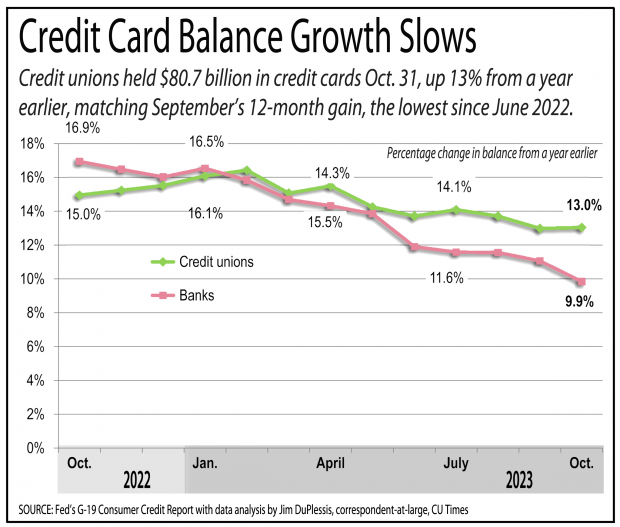
Credit unions increased their credit card balances in October at the slowest rate in more than a year, but managed to pick up share from banks, which grew balances at an even slower pace.
Data from the Fed's G-19 Consumer Credit Report released Thursday showed credit unions held $80.7 billion in credit card debt Oct. 31, up 13% from a year earlier, which matched September's 12-month gain, which was the weakest gain for credit unions since June 2022.
Recommended For You
But credit unions' gain was a strong 1.45% from September to October, compared with an average September-to-October gain of 0.4% measured from October 2016 to October 2022.
Credit unions' share was 6.4% in October, up from 6.3% in September and 6.2% a year earlier.
Banks held $1.1 trillion in credit card debt, up 9.9% from a year earlier, their lowest gain since January 2022. The gain was 0.3% from September to October, compared with a seven-year average October gain of 0.9%.
Banks' share was 90.4% in October, down from 90.5% in September, but up from 90.2% a year earlier.
Finance companies held $20.4 billion in credit card debt, down 6.8% from a year earlier. Balances were essentially flat from September to October, compared with a seven-year average drop of 0.3%.
Credit unions also outperformed banks for non-revolving consumer debt. In September, 47%, or $1.7 trillion, of the $3.7 trillion category was student loans held by the federal government.
The remaining $2 trillion held by banks, credit unions and other private lenders included $1.6 trillion in automobile loans and $418 billion in other consumer term loans, such as unsecured personal loans.
Credit unions held $585.4 billion in consumer term loans on Oct. 31, up 6.4% from a year earlier. Credit unions' gain from September to October was 0.2%, compared with a seven-year average October gain of 0.8%. Credit unions' share of non-revolving loans was 15.8% in October, a slight improvement with rounding from 15.7% in September and 15.0% a year earlier.
Banks held $922.2 billion in non-revolving consumer debt on Oct. 31, down 1.8% from a year earlier. Banks' drop from September to October was 0.5%, compared with a seven-year average October decline of 0.6%. Banks' share of non-revolving loans was 24.8% in October, down from 24.9% in September and 25.6% a year earlier.
© Touchpoint Markets, All Rights Reserved. Request academic re-use from www.copyright.com. All other uses, submit a request to [email protected]. For more inforrmation visit Asset & Logo Licensing.







